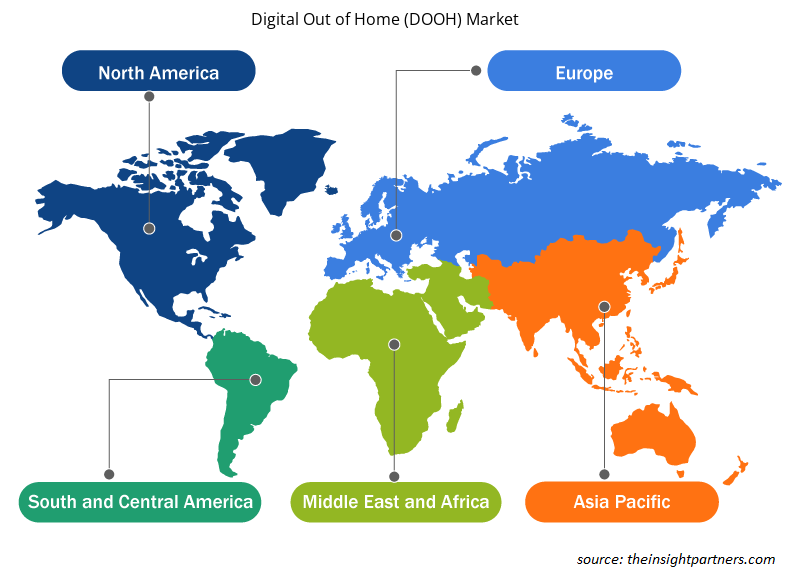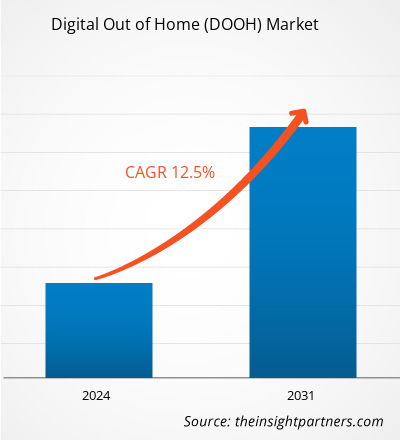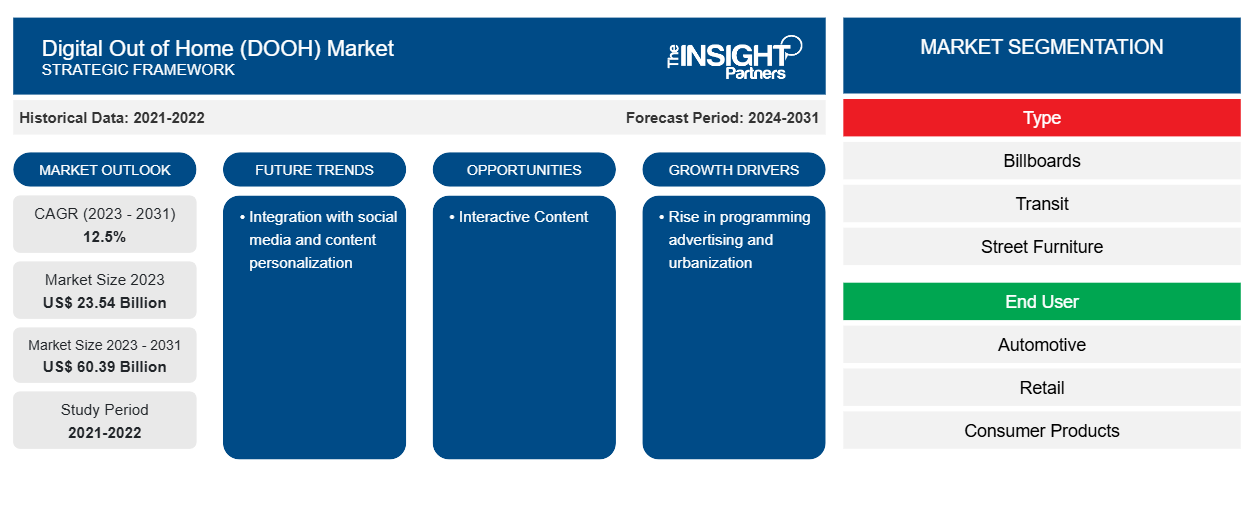Das Marktvolumen für Digital Out of Home ( DOOH ) soll von 23,54 Milliarden US-Dollar im Jahr 2023 auf 60,39 Milliarden US-Dollar im Jahr 2031 anwachsen. Der Markt wird voraussichtlich zwischen 2023 und 2031 eine durchschnittliche jährliche Wachstumsrate (CAGR ) von 12,5 % verzeichnen. Die Integration von sozialen Medien und interaktiven Inhalten dürften weiterhin die wichtigsten Trends im Markt für Digital Out of Home ( DOOH ) bleiben.
Digital Out of Home (DOOH) MarktanalyseDOOH) Market Analysis
DOOH ist ein neuartiger Medientyp, der als Außenwerbung oder Out-of-Home-Werbung (OOH) bekannt ist. Im Gegensatz zu Online- und anderen gerätebasierten digitalen Marketingmaßnahmen sind DOOH-Medien auf Werbetafeln, LED-Bildschirmen und digitalen Beschilderungen an stark frequentierten öffentlichen Orten zu sehen, an denen die Menschen bereits Zeit außerhalb ihrer Häuser verbringen. Dadurch können Vermarkter mühelos mit Verbrauchern in Kontakt treten, während diese ihrem täglichen Leben nachgehen, und kontextrelevante Inhalte in großem Umfang an Zielgruppen liefern. is a novel type of media known as outdoor or out-of-home (OOH) advertising. DOOH media, as opposed to online and other device-based digital marketing, is seen on billboards, LED screens, and digital signage in high-traffic public locations where people already spend time outside of their homes. It enables marketers to effortlessly connect with consumers as they go about their daily lives, delivering contextually relevant content to target audiences on a large scale.
Digital Out of Home (DOOH) MarktübersichtDOOH) Market Overview
Digitale Außenwerbung (OOH) ist für Vermarkter zu einer immer stärkeren und erfolgreicheren Plattform geworden, um mit realen Verbrauchern zu kommunizieren. Die DOOH-Landschaft verändert sich ständig, da die Technologie voranschreitet und sich das Verbraucherverhalten ändert. Einer der Hauptvorteile digitaler OOH-Werbung ist die Möglichkeit, Daten zu sammeln und die Wirksamkeit von Kampagnen zu verfolgen.DOOH landscape is constantly shifting as technology advances and consumer behaviors shift. One of the major benefits of digital OOH advertising is the ability to collect data and track campaign efficacy.
Passen Sie diesen Bericht Ihren Anforderungen an
Sie erhalten kostenlose Anpassungen an jedem Bericht, einschließlich Teilen dieses Berichts oder einer Analyse auf Länderebene, eines Excel-Datenpakets sowie tolle Angebote und Rabatte für Start-ups und Universitäten.
-
Holen Sie sich die wichtigsten Markttrends aus diesem Bericht.Dieses KOSTENLOSE Beispiel umfasst eine Datenanalyse von Markttrends bis hin zu Schätzungen und Prognosen.
Digital Out of Home ( DOOH ) Markttreiber und Chancen
Anstieg der programmatischen Werbung auf Favor Market
Programmatic Advertising verändert die Art und Weise, wie Online-Werbung angezeigt wird, und das Gleiche gilt mittlerweile auch für Werbung in öffentlichen Bereichen. In Zukunft wird Programmatic Advertising in diesen öffentlichen Bereichen noch wichtiger sein. Es ermöglicht Werbetreibenden, Werbeflächen automatisch in Echtzeit zu kaufen und zu verkaufen. Dies erleichtert ihnen die Arbeit und ermöglicht es ihnen, die richtigen Personen zur richtigen Zeit mit ihrer Werbung anzusprechen. Mithilfe von Daten und Erkenntnissen können Werbetreibende gezielte Werbung entwickeln, die für die Personen, die sie sehen, relevant ist. Dies führt zu effektiverer Werbung.
Interaktive Inhalte – eine Chance im Digital Out of Home ( DOOH )-Markt
Verbraucher suchen zunehmend nach immersiven Erlebnissen , die über das passive Betrachten hinausgehen. Als Reaktion darauf werden in die OOH-Werbung interaktive Aspekte integriert, um sie ansprechender zu gestalten. Touchscreens, Augmented Reality (AR) und Virtual Reality (VR) werden in digitale Displays integriert, sodass Verbraucher in Echtzeit mit Material und Unternehmen interagieren können.VR) are being incorporated into digital displays, allowing consumers to engage with material and companies in real-time.
Digital Out of Home (DOOH) Marktbericht SegmentierungsanalyseDOOH) Market Report Segmentation Analysis
Schlüsselsegmente, die zur Ableitung der Digital Out of Home (DOOH)-Marktanalyse beigetragen haben, sind Typ und Endbenutzer.
- Basierend auf dem Typ ist der Digital-Out-of-Home-Markt (DOOH) in Werbetafeln, Transit, Straßenmöbel und ortsbezogen unterteilt. Das Segment der Werbetafeln hatte im Jahr 2023 den größten Marktanteil.
- Basierend auf dem Endbenutzer ist der Digital-Out-of-Home-Markt (DOOH) in die Bereiche Automobil, Einzelhandel, Konsumgüter, BFSI, Telekommunikation und Sonstige unterteilt.
Digital Out of Home (DOOH) Marktanteilsanalyse nach Geografie
Der geografische Umfang des Digital Out of Home (DOOH)-Marktberichts ist hauptsächlich in fünf Regionen unterteilt: Nordamerika, Asien-Pazifik, Europa, Naher Osten und Afrika sowie Südamerika/Süd- und Mittelamerika.
Nordamerika dominiert dieDigital Out of Home (DOOH)-Markt. Eine fortschrittliche technologische Infrastruktur, die hochwertige Displays unterstützt, treibt die Nachfrage nach Digital Out of Home (DOOH)-Märkten in der Region an.
Regionale Einblicke in den Digital Out of Home (DOOH)-Markt
Die regionalen Trends und Faktoren, die den Digital Out of Home (DOOH)-Markt während des gesamten Prognosezeitraums beeinflussen, wurden von den Analysten von Insight Partners ausführlich erläutert. In diesem Abschnitt werden auch die Marktsegmente und die Geografie von Digital Out of Home (DOOH) in Nordamerika, Europa, im asiatisch-pazifischen Raum, im Nahen Osten und Afrika sowie in Süd- und Mittelamerika erörtert.

- Holen Sie sich regionale Daten zum Digital Out of Home (DOOH)-Markt
Umfang des Digital Out of Home (DOOH)-Marktberichts
| Berichtsattribut | Details |
|---|---|
| Marktgröße im Jahr 2023 | 23,54 Milliarden US-Dollar |
| Marktgröße bis 2031 | 60,39 Milliarden US-Dollar |
| Globale CAGR (2023 - 2031) | 12,5 % |
| Historische Daten | 2021-2022 |
| Prognosezeitraum | 2024–2031 |
| Abgedeckte Segmente |
Nach Typ
|
| Abgedeckte Regionen und Länder |
Nordamerika
|
| Marktführer und wichtige Unternehmensprofile |
|
Dichte der Marktteilnehmer für Digital Out of Home (DOOH): Die Auswirkungen auf die Geschäftsdynamik verstehen
Der Markt für Digital Out of Home (DOOH) wächst rasant. Dies wird durch die steigende Nachfrage der Endnutzer aufgrund von Faktoren wie sich entwickelnden Verbraucherpräferenzen, technologischen Fortschritten und einem größeren Bewusstsein für die Vorteile des Produkts vorangetrieben. Mit der steigenden Nachfrage erweitern Unternehmen ihr Angebot, entwickeln Innovationen, um die Bedürfnisse der Verbraucher zu erfüllen, und nutzen neue Trends, was das Marktwachstum weiter ankurbelt.
Die Marktteilnehmerdichte bezieht sich auf die Verteilung der Firmen oder Unternehmen, die in einem bestimmten Markt oder einer bestimmten Branche tätig sind. Sie gibt an, wie viele Wettbewerber (Marktteilnehmer) in einem bestimmten Marktraum im Verhältnis zu seiner Größe oder seinem gesamten Marktwert präsent sind.
Die wichtigsten Unternehmen auf dem Digital Out of Home (DOOH)-Markt sind:
- Clear Channel Outdoor, LLC
- Broadsign International, Inc
- Outfront Media Inc
- Samsung Electronics Co. Ltd
- Lamar Werbeagentur
- NEC Corporation
Haftungsausschluss : Die oben aufgeführten Unternehmen sind nicht in einer bestimmten Reihenfolge aufgeführt.

- Überblick über die wichtigsten Akteure auf dem Digital Out of Home (DOOH)-Markt
Digital Out of Home (DOOH) Marktnachrichten und aktuelle Entwicklungen
Der Digital Out of Home (DOOH)-Markt wird durch die Erfassung qualitativer und quantitativer Daten nach Primär- und Sekundärforschung bewertet, die wichtige Unternehmensveröffentlichungen, Verbandsdaten und Datenbanken umfasst. Im Folgenden finden Sie eine Liste der Entwicklungen auf dem Markt für Digital Out of Home (DOOH) und Strategien:
- Heritage Outdoor Media arbeitete mit Daktronics zusammen, um eine digitale SMD-Werbetafel mit 8 Millimeter Auflösung am Bow Tie Building in 1530 Broadway am Times Square in New York zu erstellen. Die Torkian Group beteiligte sich ebenfalls an der Vereinbarung als Einzelhandelsmieter für das Schild, das als „New York, New York“-Schild bekannt ist und versucht, das DOOH-Erlebnis am Times Square aufzubrechen, indem es neue Technologieerlebnisse wie Augmented Reality und mobile Interaktion einbezieht. (Quelle: Daktronics, Inc, Pressemitteilung, 2022)
Marktbericht zu Digital Out of Home (DOOH) – Abdeckung und Ergebnisse
Der Bericht „Digital Out of Home (DOOH)-Marktgröße und -Prognose (2021–2031)“ bietet eine detaillierte Analyse des Marktes, die die folgenden Bereiche abdeckt:
- Marktgröße und Prognose auf globaler, regionaler und Länderebene für alle wichtigen Marktsegmente, die im Rahmen des Projekts abgedeckt sind
- Marktdynamik wie Treiber, Beschränkungen und wichtige Chancen
- Wichtige Zukunftstrends
- Detaillierte PEST/Porters Five Forces- und SWOT-Analyse
- Globale und regionale Marktanalyse mit wichtigen Markttrends, wichtigen Akteuren, Vorschriften und aktuellen Marktentwicklungen
- Branchenlandschaft und Wettbewerbsanalyse, einschließlich Marktkonzentration, Heatmap-Analyse, prominenten Akteuren und aktuellen Entwicklungen
- Detaillierte Firmenprofile
- Historische Analyse (2 Jahre), Basisjahr, Prognose (7 Jahre) mit CAGR
- PEST- und SWOT-Analyse
- Marktgröße Wert/Volumen – Global, Regional, Land
- Branchen- und Wettbewerbslandschaft
- Excel-Datensatz
Aktuelle Berichte
Erfahrungsberichte
Grund zum Kauf
- Fundierte Entscheidungsfindung
- Marktdynamik verstehen
- Wettbewerbsanalyse
- Kundeneinblicke
- Marktprognosen
- Risikominimierung
- Strategische Planung
- Investitionsbegründung
- Identifizierung neuer Märkte
- Verbesserung von Marketingstrategien
- Steigerung der Betriebseffizienz
- Anpassung an regulatorische Trends























 Kostenlose Probe anfordern für - Digital Out of Home (DOOH)-Markt
Kostenlose Probe anfordern für - Digital Out of Home (DOOH)-Markt